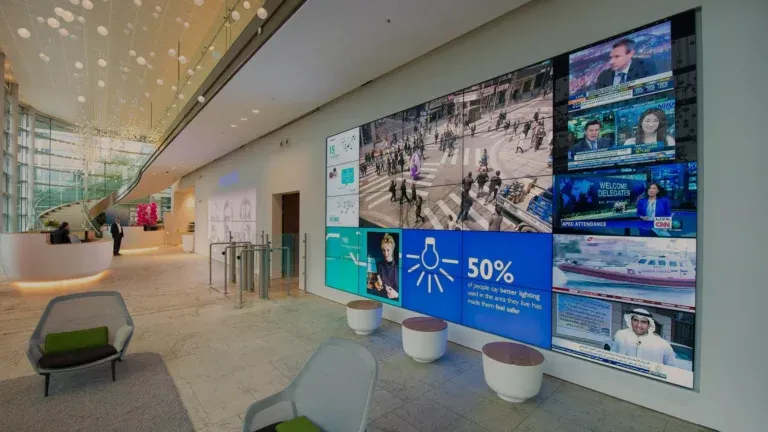Digital signage for advertising – 5 possible locations for installing
Digital signage for advertising - how to choose the best location for placing?
When you first think about where to place screens, most likely everything seems obvious. You choose an empty wall right near the entrance to the establishment or right in the center of the room. But in reality, it’s not that simple. To make an informed choice of location, a thorough and strategic approach is needed. In this article, we will discuss the most important factors to keep in mind when placing digital screens.
Locations for placing digital signage for advertising
Let’s consider the most popular options:
1. Interior walls
One of the most common places where you can see digital signage for advertising is interior walls. Screens are either placed flush with the surface or at an angle. They are often placed in areas with high foot traffic.
2. Floor
Floor digital signage for advertising stands for advertising are typically used in exhibition halls, shopping malls, retail stores, transportation hubs, and restaurants. These can be interactive kiosks or standalone screens.
3. Windows/Display windows
Due to the high foot traffic, a window is one of the key advertising spaces for a business. Such placement will attract the attention of a large number of people, enhancing the recognition of your brand. Digital signage for advertising on windows is so eye-catching that they are virtually impossible to miss.
4. Checkout areas
Small screens are typically placed behind the checkout counter. They not only reduce the waiting time for clients by entertaining them with interesting advertising content but also help increase sales.
5. Waiting areas
Often people get irritated by waiting, even if it takes a short time. By placing screens in waiting areas, you can divert the attention of clients, improve their mood, and simultaneously introduce them to specific offers.
Tips on placing digital signage for advertising
A wisely chosen location is the key to attracting the attention of the target audience.
What to consider when placing digital signage for advertising:
Content
Before you decide where to place the screens, you should determine what will be displayed on them. When choosing a location for the screen, think about who your target audience is and what you want to show them.
If you plan to broadcast the weather and traffic jams, then you should place screens near the exits.
If the content is interactive, make sure that people can easily interact with the screens.
If you plan to use audio, don’t place displays with speakers in quiet areas.
Start by defining your goals. Think about when and where it will be interesting and necessary for the audience to familiarize themselves with the broadcasted information. Choose a location that best meets your goals and criteria.
Accessibility
Even the largest and brightest digital signage for advertising won’t be able to attract the proper amount of attention if it’s installed high under the ceiling where no one will notice it. It’s desirable to place displays at eye level or slightly above. Since the “eye height” of individual clients varies, one should use an approximate estimation of their average height to properly position the screens.
Also, one should avoid glares from windows or overhead lighting that can negatively impact the visibility of broadcasted messages.
Accessibility is especially important for interactive content. If you have touch screens, make sure they are comfortable for most people to interact with (for example, you can place control elements at the bottom of the screen).
Traffic
Areas with high foot traffic are best suited for placing digital screens. This may seem obvious, but sometimes this option is overlooked, for instance, due to networking issues. It’s great if you have a solid wall with already laid network cables for screens. But if it’s located in a side corridor with low traffic, you won’t get the maximum return on your investment. Walk around the premises, familiarize yourself with its layout and pay attention to areas with high foot traffic.
Ask yourself the following questions:
What do customers do? Do they usually just walk by? Or are there specific places where queues might form?
Where do customers stop?
Are there any obstacles in the premises, such as columns, stairs, or partitions that might obstruct viewing the content?
If you identify an area where people linger and spend more time, it might be the best place to position the display.
Example of Installing Digital signage for advertising in the Transportation Sector
Digital Signage finds its application in many spheres: education, fitness, retail, hotels, and restaurants. The transportation sector is no exception. Airports, bus stops, railway stations, and even ferry terminals can operate more efficiently thanks to the implementation of Digital Signage solutions. We detail below the benefits brought by Digital signage for advertisingand how such digital solutions can be used in the transportation sphere.
Schedule
The most common example of using digital signs in the transportation field is for displaying schedules. Digital screens broadcast the departure/arrival times of flights, trains, and buses, and when needed, in different languages. No solution is able to inform passengers so effectively. This is especially relevant when details about locations, times, gates, and flight numbers are constantly changing. And it is precisely digital signs that allow for instant and remote updating and content modification.
Waiting
Long queues and crowds are tiring. In such cases, digital screens can be used strategically: for instance, to inform passengers about where the line starts, how long the wait will be, when the next bus will arrive, and so on. This helps calm the nerves of passengers who are already stressed from traveling and a long journey. Moreover, with the feature of managing screens, Digital Signage allows the display of not only informational messages but also entertainment content (cartoons, movies, YouTube videos, etc.), making the wait less exhausting.
Advertising on Digital Signage
Digital displays provide a fantastic opportunity to generate additional revenue by selling advertising space on the screens to third-party advertisers. This is especially relevant for the transportation sector, where displays are placed in high-footfall areas. Moreover, they broadcast essential information that almost all passengers keep an eye on. Therefore, the chances of screens being ignored are extremely slim. The content will be noticed! This makes digital displays in the transportation sector a valuable advertising tool.
Navigation
Digital screens can assist passengers in navigating the vast and intricate premises of airports and stations. Such navigation can consist of interactive maps, hanging displays, digital directories, and signs that highlight crucial landmarks (for example, exit numbers, baggage claim areas, taxi stands, etc.). With the use of software for LED screens, a significant advantage is that digital landmarks, signs, and maps allow the staff to address more essential tasks, freeing them from constantly aiding travelers in finding their way.
Safety
Digital Signage can play a significant role in ensuring travelers’ safety. With the ability to instantly update content using software for LED screens, digital displays can promptly transmit emergency messages. This allows for timely informing large crowds about emergency situations or safety threats. Using Digital Signage in such cases is the most efficient and fastest way of notification.
Screen Size
Large displays are one of the most common and popular options for digital signs. However, the capabilities of small screens should not be overlooked. Sometimes, a small display that shows one message can be more effective than a large screen with multiple zones broadcasting different messages.
It’s essential to design content keeping in mind where it will be displayed. For small screens, make the messages brief. When making the final decision, consider the sizes of the actual places where the signs will be positioned. Ensure that your digital signs will be located so that they are easily visible, and viewers can conveniently read the displayed messages.
Environment
The surrounding environment can either assist or impede the success of your Digital Signage campaigns. Suppose you use a digital sign in your retail space and have positioned it among clothing racks. There’s a good chance your display won’t be noticed, and if it does, it might not hold the viewer’s attention for long. For greater success, place your display in an area with fewer competing visual objects. You might consider moving it higher up on the wall, above shelves, or on an empty wall opposite clothing racks.
To ensure your display is not overly conspicuous and harmonizes with the interior, consider how you can elegantly integrate digital signs into the space using digital signage software cloud. Many of the most effective digital boards are integrated into spaces in unobtrusive yet noticeable ways, leveraging the architectural features of the room.
Determining a place for advertising screens is not simple. It’s essential to consider the above-mentioned factors to position displays most advantageously. Digital signs should not merely serve as a way to fill an empty space on a wall.
If you are contemplating the implementation of a Digital Signage project, aim for strategic placement of screens to maximize audience reach. Please turn to Advision.
Share the news




















